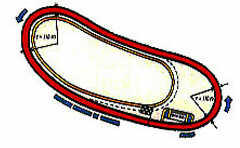
The venture was not financially sound, and the distance from Barcelona caused additional difficulty. The rapidly escalating performances of racing vehicles soon resulted in the track becoming insufficient for the requirements of racing, and after the takings of the first meetings were seized by the constructors, making it impossible to pay the prizes, international races were prohibited.
In 1925 the track was virtually abandoned, but the Catalunyan Automobile Club and the Penya Rhin started to run it, although without much success. Edgard de Morawitz purchased the track at the beginning of the 1930s, and in 1932 the Spanish Track Motorcycling Championship was held, and in the 1950s a speed race of the VI "Volta a Catalunya" competition. After these events, the Sitges motor racing circuit was completely abandoned.